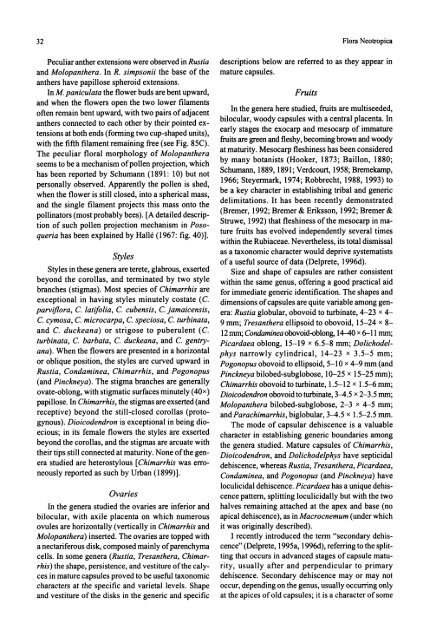Rondeletieae (Rubiaceae): Part I (Rustia, Tresanthera ... - CNCFlora
Rondeletieae (Rubiaceae): Part I (Rustia, Tresanthera ... - CNCFlora
Rondeletieae (Rubiaceae): Part I (Rustia, Tresanthera ... - CNCFlora
Create successful ePaper yourself
Turn your PDF publications into a flip-book with our unique Google optimized e-Paper software.
32 Flora Neotropica<br />
Peculiar anther extensions were observed in <strong>Rustia</strong><br />
and Molopanthera. In R. simpsonii the base of the<br />
anthers have papillose spheroid extensions.<br />
In M. paniculata the flower buds are bent upward,<br />
and when the flowers open the two lower filaments<br />
often remain bent upward, with two pairs of adjacent<br />
anthers connected to each other by their pointed ex-<br />
tensions at both ends (forming two cup-shaped units),<br />
with the fifth filament remaining free (see Fig. 85C).<br />
The peculiar floral morphology of Molopanthera<br />
seems to be a mechanism of pollen projection, which<br />
has been reported by Schumann (1891: 10) but not<br />
personally observed. Apparently the pollen is shed,<br />
when the flower is still closed, into a spherical mass,<br />
and the single filament projects this mass onto the<br />
pollinators (most probably bees). [A detailed descrip-<br />
tion of such pollen projection mechanism in Poso-<br />
queria has been explained by Halle (1967: fig. 40)].<br />
Styles<br />
Styles in these genera are terete, glabrous, exserted<br />
beyond the corollas, and terminated by two style<br />
branches (stigmas). Most species of Chimarrhis are<br />
exceptional in having styles minutely costate (C.<br />
parviflora, C. latifolia, C. cubensis, C. jamaicensis,<br />
C. cymosa, C. microcarpa, C. speciosa, C. turbinata,<br />
and C. duckeana) or strigose to puberulent (C.<br />
turbinata, C. barbata, C. duckeana, and C. gentryana).<br />
When the flowers are presented in a horizontal<br />
or oblique position, the styles are curved upward in<br />
<strong>Rustia</strong>, Condaminea, Chimarrhis, and Pogonopus<br />
(and Pinckneya). The stigma branches are generally<br />
ovate-oblong, with stigmatic surfaces minutely (40x)<br />
papillose. In Chimarrhis, the stigmas are exserted (and<br />
receptive) beyond the still-closed corollas (protogynous).<br />
Dioicodendron is exceptional in being dioecious;<br />
in its female flowers the styles are exserted<br />
beyond the corollas, and the stigmas are arcuate with<br />
their tips still connected at maturity. None of the genera<br />
studied are heterostylous [Chimarrhis was erroneously<br />
reported as such by Urban (1899)].<br />
Ovaries<br />
In the genera studied the ovaries are inferior and<br />
bilocular, with axile placenta on which numerous<br />
ovules are horizontally (vertically in Chimarrhis and<br />
Molopanthera) inserted. The ovaries are topped with<br />
a nectariferous disk, composed mainly of parenchyma<br />
cells. In some genera (<strong>Rustia</strong>, <strong>Tresanthera</strong>, Chimar-<br />
rhis) the shape, persistence, and vestiture of the caly-<br />
ces in mature capsules proved to be useful taxonomic<br />
characters at the specific and varietal levels. Shape<br />
and vestiture of the disks in the generic and specific<br />
descriptions below are referred to as they appear in<br />
mature capsules.<br />
Fruits<br />
In the genera here studied, fruits are multiseeded,<br />
bilocular, woody capsules with a central placenta. In<br />
early stages the exocarp and mesocarp of immature<br />
fruits are green and fleshy, becoming brown and woody<br />
at maturity. Mesocarp fleshiness has been considered<br />
by many botanists (Hooker, 1873; Baillon, 1880;<br />
Schumann, 1889, 1891; Verdcourt, 1958; Bremekamp,<br />
1966; Steyermark, 1974; Robbrecht, 1988, 1993) to<br />
be a key character in establishing tribal and generic<br />
delimitations. It has been recently demonstrated<br />
(Bremer, 1992; Bremer & Eriksson, 1992; Bremer &<br />
Struwe, 1992) that fleshiness of the mesocarp in mature<br />
fruits has evolved independently several times<br />
within the <strong>Rubiaceae</strong>. Nevertheless, its total dismissal<br />
as a taxonomic character would deprive systematists<br />
of a useful source of data (Delprete, 1996d).<br />
Size and shape of capsules are rather consistent<br />
within the same genus, offering a good practical aid<br />
for immediate generic identification. The shapes and<br />
dimensions of capsules are quite variable among genera:<br />
<strong>Rustia</strong> globular, obovoid to turbinate, 4-23 x 4-<br />
9 mm; <strong>Tresanthera</strong> ellipsoid to obovoid, 15-24 x 8-<br />
12 mm; Condaminea obovoid-oblong, 14-40 x 6-11 mm;<br />
Picardaea oblong, 15-19 x 6.5-8 mm; Dolichodel-<br />
phys narrowly cylindrical, 14-23 x 3.5-5 mm;<br />
Pogonopus obovoid to ellipsoid, 5-10 x 4-9 mm (and<br />
Pinckneya bilobed-subglobose, 10-25 x 15-25 mm);<br />
Chimarrhis obovoid to turbinate, 1.5-12 x 1.5-6 mm;<br />
Dioicodendron obovoid to turbinate, 3-4.5 x 2-3.5 mm;<br />
Molopanthera bilobed-subglobose, 2-3 x 4-5 mm;<br />
and Parachimarrhis, biglobular, 3-4.5 x 1.5-2.5 mm.<br />
The mode of capsular dehiscence is a valuable<br />
character in establishing generic boundaries among<br />
the genera studied. Mature capsules of Chimarrhis,<br />
Dioicodendron, and Dolichodelphys have septicidal<br />
dehiscence, whereas <strong>Rustia</strong>, <strong>Tresanthera</strong>, Picardaea,<br />
Condaminea, and Pogonopus (and Pinckneya) have<br />
loculicidal dehiscence. Picardaea has a unique dehiscence<br />
pattern, splitting loculicidally but with the two<br />
halves remaining attached at the apex and base (no<br />
apical dehiscence), as in Macrocnemum (under which<br />
it was originally described).<br />
I recently introduced the term "secondary dehiscence"<br />
(Delprete, 1995a, 1996d), referring to the splitting<br />
that occurs in advanced stages of capsule maturity,<br />
usually after and perpendicular to primary<br />
dehiscence. Secondary dehiscence may or may not<br />
occur, depending on the genus, usually occurring only<br />
at the apices of old capsules; it is a character of some
















